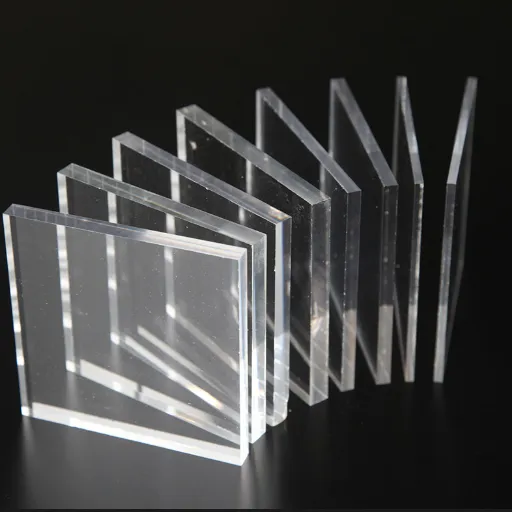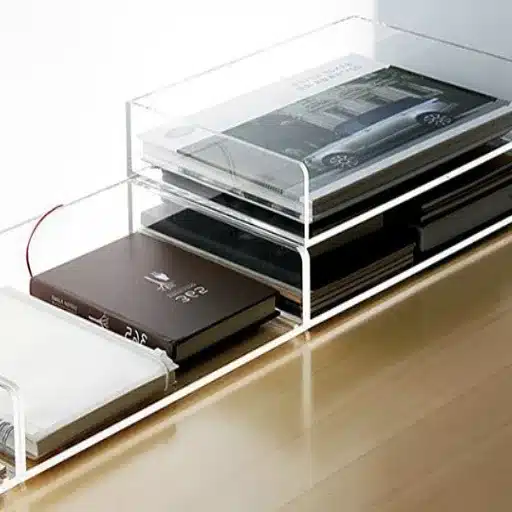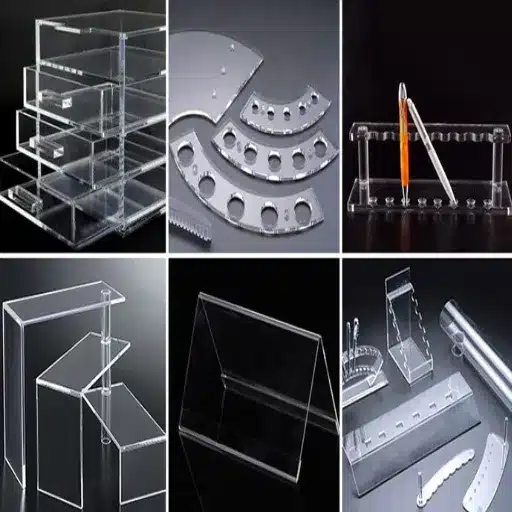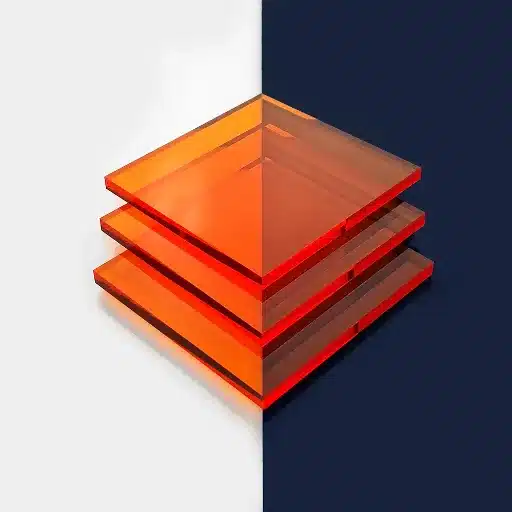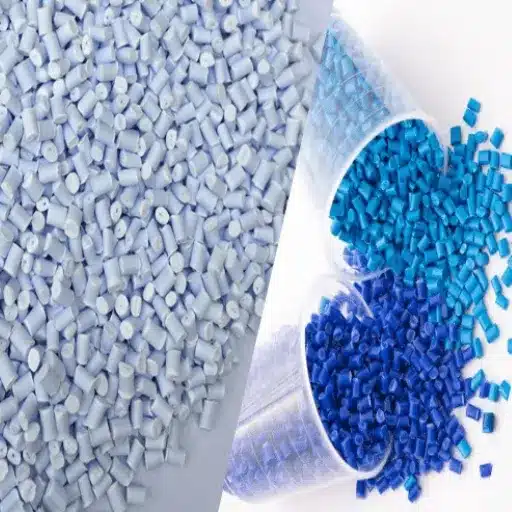With acrylic, with all its possibilities, including dimension, creativity, color, and durability, acrylic has literally brought change in art and design. Whether it is an expressionistic contemporary painting with bold brush strokes, modern furniture with smooth lines, or extravagant sculptural installations, this material keeps the artists and designers very much at the creative helm. The article aims to inform about how acrylic evolved from an artistic medium to a component of functional design due to its unique properties and extensive applications. From fine arts to interior design, we will investigate some key factors keeping acrylic alive as a means to push creative envelopes. Prepare to journey through some of the limitless applications and current advancements in acrylic material today.
Understanding Acrylic: The Material and Its Properties
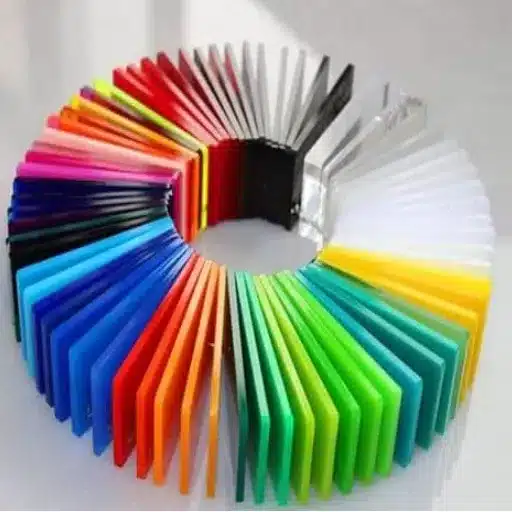
What is Acrylic and Its Composition?
Acrylic, or the polymethyl methacrylate, is a very versatile thermoplastic material that is never to be lost for being lightweight, highly durable, and completely transparent like glass. This synthetic polymer is formed from the polymerization of methyl methacrylate (MMA) monomers that create a homopolymer highly resistant to impact and weathering. Because of its supreme clarity and strength, acrylic is commonly selected in place of glass, as it is up to 17 times more impact-resistant and weighs significantly less.
Acrylic’s versatility is demonstrated by its many embodiments, including sheets, rods, and tubes, making it usable by a wide range of industries, including construction, automotive, and artistic design. Being non-toxic and UV resistant, some applications cater to outdoor use: such as spaces designated for children where utmost safety is paramount. Acrylic can be molded and fabricated through processes like molding, laser cutting, and thermoforming for practical or artistic applications.
With continuous improvements in manufacturing, variations of acrylic have been created to improve further its characteristics, including abrasion-resistant glazing, anti-glare finishes, colored glazing, and frosted glazing. With its unique combination of aesthetic and structural character, acrylic continues to mark and directly support innovations that design and industrial spheres rely on for contemporary applications.
Properties of Acrylic: Why Choose Acrylic Material?
Acrylic is suitable for versatility and performing across industries. Its optical clarity, approximately 92% light transmittance, rivals that of glass, thereby affording a clear, polished look for high visibility applications. Also, acrylic weighs half as much as glass and is much stronger, providing impact resistance that mainly prevents breaking and shattering. These qualities place it in good standing for safety audits.
The acrylic material also excels at resisting weather effects. In contrast to other materials, acrylic will retain its clarity and durability for extended periods; therefore, it can withstand sunlight, rain, and varying temperatures in moderate outdoor conditions. Chemical inertia opens up more possibilities for using the acrylic material, putting it in a class by itself.
Beyond these physical qualities, any acrylic meets the demand for a higher degree of customizability. All types of acrylic can be shaped, cut, and thermoformed with complex designs to meet various utility and decorative needs. Acrylic comes in an infinite variety of colors, finishes, and thicknesses, paving the way for endless creative possibilities while ensuring structural integrity. Moreover, all these properties combined provide a rationale for choosing acrylic for anything, from architecture to signage, protective barriers, and consumer products.
Acrylic Vs. Plexiglass: What Makes Them Different?
Though the words acrylic and plexiglass appear to be used interchangeably, the terms are not entirely synonymous. Both of them are made from polymethyl methacrylate (PMMA), which is a transparent and thermoplastic material well recognized for being rugged and versatile. However, plexiglass is a trademark given to certain types of acrylic sheets, just like Kleenex refers to tissues in general.
In terms of properties, acrylic and plexiglass possess similar characteristics: high optical clarity, lightweight, and resistance to impact. Weather and environmental resistance, along with incredible customizability, are attributes that render it favorable across industries such as construction, design, and manufacturing. Nevertheless, there are some differences in the processes and quality control standards followed by acrylic sheet manufacturers and those for plexiglass-branded products. Plexiglass is known to be produced under stricter standards, giving better quality in terms of optical clarity and scratch resistance.
Plexiglass is known, for instance, to have slightly better UV resistance than generic acrylic; hence, it is usually the preferred material for outdoor windows, greenhouses, or signs. In addition, branded plexiglass might resist yellowing more than regular materials when exposed to the sun over time. On the contrary, acrylic sheets tend to be less expensive and more flexible in terms of thickness and color variety, providing economical options for large or decorative jobs.
This knowledge will allow companies and creators to balance the choice of material against cost, performance, and application requirements.
Types of Acrylic and Their Applications
Different Types of Acrylic Sheets and Their Thickness
Different varieties of acrylic sheets exist, catering to unique applications based on their properties and performance needs. Here are some of the significant types of acrylic sheets available and their thicknesses:
| Type of Acrylic Sheet | Thickness Range | Primary Applications |
|---|---|---|
| Transparent Acrylic Sheets | 1/16 inch to 1 inch | Signage, display cases, protection barriers |
| Colored Acrylic Sheets | 1/8 inch to 1 inch | Decorative work, branding, lighting |
| Frosted Acrylic Sheets | 1/8 inch to 3/4 inch | Office partitions, bathroom wall panels, decorative elements |
| Impact-Modified Acrylic | 1/4 inch to 1 1/2 inch | Industrial machine guards, heavy-duty outdoor fixtures |
| Light-Diffusing Acrylic | 1/8 inch to 1/2 inch | Lighting applications, signage |
| Anti-Static Acrylic Sheets | 1/16 inch to 1/4 inch | Electronics manufacturing, cleanrooms |
| Textured Acrylic Sheets | 3/32 inch to 3/8 inch | Furniture, interior designs, window paneling |
With a clear understanding of the different types, specific features, and thickness ranges of these sheets, companies or creators can make informed choices based on their project requirements. Whether you’re seeking optical clarity, strength, or just looks, the proper selection of acrylic sheets will speak for itself in terms of performance and value.
What Is Methyl Methacrylate in Acrylic?
Methyl Methacrylate (MMA) is the essential monomer for acrylic sheet manufacture, polymerizing into polymethyl methacrylate (PMMA). This crucial chemical stands between the acrylic milieu and acrylic sheets, whose excellent clarity, durability, and UV resistance allow it to be applied to various sectors, like architectural works and the automotive industry.
The demand for MMA has continually increased worldwide due to its unique properties and the growth of various industries reliant on superior-grade acrylic material. Some advanced methods of producing MMA were introduced to optimize efficiency and lessen environmental pollution. The acetone cyanohydrin (ACH) process and some newer processes with low carbon footprints are examples. For sustainable production, various manufacturers are now considering bio-based MMA obtained from renewable feedstocks.
According to statistics, the MMA markets are worth billions, with development seen in technological advancements and new applications in renewable energy. In these areas, acrylic sheets are preferred as a lightweight yet durable cover for solar panels. The compound remains adaptable and, with advancements in production technology, will continue to play a key role in fulfilling the industry’s requirement for quality acrylic products.
Applications of Acrylic Plastic in Art and Design
Acrylic plastic has indeed transformed the art and design world by providing a versatile, lightweight, and durable alternative to traditional materials such as glass and wood. Acrylic sheets for artists have a crystal-clear surface that resists yellowing with time, perfect for contemporary sculpture, frames, and even installation art. Designers make use of acrylic for its versatility and ability to be thermoformed into complex shapes for designing furniture, decorative panels, lighting fixtures, and more.
Cutting-edge, modern acrylic lends an entire third layer to creative works, offering options for incisively colorful designs or delicately frosted lucidity. In the limelight, acrylic is widely seen in partitions, signage, and decorative applications. Because it holds up exceptionally well to weather conditions, acrylic stands high as a choice for outdoor art installations by fabulous design houses and luminary sculptors. The potential for fading and discoloration from UV rays and adverse weather is a non-issue in such cases.
The data reveals that acrylic applications have increased due to the growth in precision cutting and engraving for custom work, ranging from laser-cut jewelry designs to trophies and awards with intricate details. Further, improvements in production maintain the acrylic’s clarity while making it 50% lighter than glass, which is crucial for reducing transportation and installation costs on large projects. Thus, it is these very characteristics of acrylic that have led to the plastic becoming a key material for the arts and design arena, fostering the growth of innovation while also coping with ever-increasing demands for sustainable materials and those materials that differ in aesthetic versatility.
Working with Acrylic: Tips and Techniques
Cutting and Shaping of Acrylic Sheets
To cut and shape acrylic sheets perfectly and stylishly, the appropriate fine tools must be used. It can be cut with a circular saw fitted with a fine-tooth blade to reduce chipping along the edges. It is another method that guarantees smooth and polished edges without the need for finishing when working on elaborate designs. The acrylic can be shaped when heated to its thermoforming temperature, when it becomes soft and pliable. Heating may be in the form of strip heaters or an oven where the acrylic is heated and then bent into its desired shape, with caution taken to avoid uneven heat.
⚠️ Safety First: Acrylic must always have a clamp or support to prevent its movement while being cut and shaped. The protective film on the sheets should remain until the final stages to prevent scratches. Drilling and routing acrylic requires consideration of speed and pressure to avoid cracking or breaking. Safety measures should be observed: wearing goggles and having adequate ventilation can protect one from the hazards of acrylic dust and fumes. Careful preparation and suitable tools combine to enhance accuracy and ensure the integrity and appearance of the material.
Acrylic Project Finishing Techniques
Acrylic work requires precise finishing to appear professional. Roughness must be eliminated, and a seamless look must be achieved on the edges, which are formed after the acrylic is cut or shaped. Begin sanding the edges of the acrylic using different sandpapers, starting with the coarser side (120 grit) and progressing to finer grits (600 grit or higher) to achieve smoothness. Wet sanding is especially recommended as a precaution against heat buildup and surface damage.
Polishing is crucial to maintain a mirror finish on edges or surfaces. The material should be polished with an abrasive wheel or a soft cloth using a plastic polishing compound to reach its full gloss. Polish with equal pressure to avoid introducing polishing marks or scratches. Another refinement method is flame polishing, which is suitable for achieving accurate edges but requires skill and practice to prevent overheating or distortion of the material. In flame polishing, the flame is gently passed over the edge surfaces to melt and smooth them, giving a clear finish.
Lastly, cleaning the finished acrylic is probably the most essential step in retaining its clarity and brilliance. Wash out the dust and fingerprints using a dust-free cleaner and a non-abrasive microfiber cloth. Do not use harsh chemicals containing ammonia, as they will cloud the surface or develop micro-cracks over time. With such detailed finishing techniques, you can make your acrylic projects look professional and stand the tests of time in terms of durability and appeal.
Incorporating Acrylic into Mixed-Media Art
Acrylic paints, being versatile, are among the first products used in mixed media art. Fast drying allows the artist to layer it with other mediums such as watercolor, ink, or pastel, adding extra texture and depth to the piece. Furthermore, acrylics adhere to almost all materials, such as canvas, wood, paper, and even metal, allowing the artist to experiment with offbeat forms of art. Acrylic combined with medium gel or modeling paste produces assertive three-dimensional effects that uplift the visual appeal of a shape.
According to specific sources, a combination of acrylic markers and thinned acrylics will give you those bright highlights or fine lines needed for a multilayered composition. Recent art studies have shown an evolution whereby acrylics may also serve as a binding or sealing medium in epoxy or mixed-media collages. This ensures longevity while avoiding damage to the various fragile materials used within the works, such as paper and comfort fabric. By interfacing acrylics with multiple media, mixed-media artists can generate highly dynamic and original artworks.
Questions About Acrylics and Their Uses
Selecting a Suitable Thickness for Acrylic Sheets
This question has the following answer: The thickness of acrylic sheets essentially depends on the application they are intended for. For picture frames or display cases, they will suffice in thinner sheets measuring about 3 (mm) or 1/8 (inch) thick, in the idea that maximum clarity is desired, while minimum weight should be added. If the acrylic sheets were to be used for heavy purposes such as shelving or protective barriers, thicker sheets such as 6 (mm) or 1/4 (inch) ought to be selected for their extra strength and rigidity. In cases of industrial or structural use, such as windows or signage installations, they need to be 10 mm or more in thickness to ensure adequate stability and weathering. Studies recommend that when choosing between weight, flexibility, and resistance to bending for a particular thickness, the specific project must first be considered.
How Does Acrylic Compare to Other Plastics?
Among other plastics, acrylics are known for having uncommon clarity, impact resistance, and versatility. The difference between acrylic and polycarbonate regarding optical clarity mostly disappears due to yellowing after a period of UV exposure. Due to its high level of scratch resistance and being harder than polycarbonate or PETG, acrylic is ideal for applications requiring long-term viewability.
PVC, its older promoter, is much heavier and has a different glare; its chemical resistance levels fall between its flexibility levels. In the industrial field, acrylics are sometimes less costly than polycarbonates, providing a cost-effective solution for both decorative and functional needs. Excellent transparency and durability are always features. When weather resistance, a range of thickness options, and adaptability are needed, acrylics are an excellent choice.
What Are the Care and Maintenance Tips for Acrylic?
Proper care and maintenance are required for the perfect conditions and longevity of an acrylic environment. Regularly clean with a soft black cloth or a microfiber towel to avoid scratching the surface. Mild soap and water solutions or cleaners specially designed for acrylic should be used. Harsh chemicals or ammonia-based solutions should be avoided, as they can cause clouding or degradation of the surface. Dusting with a dry cloth should be avoided as fine scratches can evolve across the surfaces. A lightly damp cloth will go a long way to gently wiping off the dust and dirt.
To preserve clarity and prevent any yellowing over time, an acrylic should be placed in locations with little ultraviolet exposure or in the case of unavoidable exposures, UV-stabilized variants should be selected. For polishing minute surface scratches, these acrylic polishing compounds work perfectly fine on the shoulder to restore the smoothed-out finish and shine to the plastic. Furthermore, acrylic should be handled very gently, as it scratches and dents more easily than glass. While it is out of use, good storage and padding will help to keep it safe against accidental impacts or abrasions. With a few such measures, the acrylic will remain transparent and durable for years.
Creative Uses of Acrylic in Modern Design
Innovative Applications of Frosted Acrylic in Interiors
Frosted acrylic is one of those substances that I’ve come to consider as being uncommonly versatile and aesthetically appealing concerning modern interior settings. One of the latest and most exciting uses is that of room dividers. Frosted acrylic panels offer privacy while still allowing light to flow through, keeping a bright and open feel in the room. Most often, they are used in residences and commercial spaces, especially in open-plan offices where collaboration needs to co-exist with areas for focused individual work. The finish is customizable, allowing these panels to fit any design style, from clean modernity to warm minimalism.
Another innovative use that I have discovered is how frosted acrylic glass creates dramatic lighting effects. The material diffuses light well, making it perfect for pendant lights, lampshades, or even illuminated wall panels. It lends the rooms a gentle, modish glow, making the atmosphere quite comfortable and yet modern. Also, it is lightweight and durable, making it far easier to work with than traditional glass.
Furniture design has been the latest victim of frosted acrylic. Designers have been incorporating this to add a layer of refinement to coffee tables, shelving, and cabinet doors — striking a delicate balance between opacity and translucency. The faint texture of frosted acrylic helps to conceal fingerprints and smudges, thus keeping maintenance to a bare minimum. With such inventive uses, I dare say that frosted acrylic has found a permanent place among those who wish to impart a touch of functional elegance into their interior design.
Using Pastel Acrylic in Contemporary Art
I love to call pastel acrylic an incredible, versatile, and inspiring medium for contemporary art. Its soft pastel tones give off a fresh, modern look that is easy to relate to and thus lend themselves well to artwork welcoming sentiment from today’s audience: flexibility is a key feature of this medium-I can paint on canvas with acrylics or use it in mixed media works to explore textures, layers, and methods. Be it wild abstract effects or subtle, intricate, lacy details, the intoxicating colors of pastel acrylic bring depth and refinement into my works.
Pastel acrylic is always the most excellent choice for my works-in-progress on any surface. It’s fantastic on wood panels, paper, and even glass for those who want to experiment. Another advantage of pastel acrylic is its matte finish, which absorbs light, allowing the artwork itself to be seen rather than a glare or reflection. Such a finishing touch becomes very important when considering its display in a gallery or any other working space. The finest qualities of today’s pastel acrylic paint include high pigmentation, strong lightfastness, and rapid drying times-a formulation that allows for time-resistance in my paintings.
Another feature I appreciate in pastel acrylics is that they can adapt to innovative tools and techniques such as stenciling, airbrushing, and pouring. These applications allow me to incorporate dynamic patterns and gradients into my pieces seamlessly. For example, in the execution of murals or large-scale installations, pastel acrylics would easily blend for a unified and subtle visual treatment. In essence, pastel acrylic remains my favorite medium to work with, providing limitless opportunities to produce engaging modern works with a timeless touch.
Environmental Considerations of Acrylic Material
While considering the environmental impact of acrylic materials, it is crucial to weigh the benefits against the drawbacks. Acrylic paints, although widely versatile and going well for their heavy pigmentation and rapid drying time, are synthetic polymers created from petroleum chemicals. Hence, their manufacture relies on the extraction of non-renewable resources, depleting natural reserves, and ultimately creating a carbon footprint associated with the processes involved in making acrylics. Moreover, several acrylic-type materials can liberate certain volatile organic compounds into the atmosphere during their use, raising issues of VOCs in indoor air quality.
Another essential matter concerning this is the disposal of acrylic material. When dried, acrylic acts essentially like plastic that does not just weather away in nature. Paint pieces and improperly disposed of wastewater may add microplastics to water systems, causing pollution and adversely affecting marine life. This has made me more environmentally conscious by adopting responsible disposal methods and alternatives whenever possible. Lately, there have been developments at the industry level, with manufacturers countering the existing trend by offering low-VOC and non-toxic acrylic formulas. This is definitely a positive step toward sustaining the earth through this highly popular medium.
I like to see materials and methods that respect nature. My aim, as a creator valuing both art and sustainability, is to abide by the highest qualities of the acrylic material while exercising conscientious usage, limiting waste, exploring biodegradable or sustainably produced products, and provoking fellow artists into a dialogue on responsible material use. I believe that the way toward more sustainable creativity posed with environmental considerations will be a rewarding one, allowing us to enjoy the myriad possibilities of acrylic through sheer ingenuity.
Reference Sources
Acrylic Polymer Transparencies
Source: Portland State University – PDXScholar
Summary: This study explores the use of transparent acrylic polymers in creating innovative art forms, including paintings on glass and plexiglass supports.
Taking the Modern with the Traditional: Introducing the Challenges of Acrylic Emulsion Painted Banners
Source:Academia.edu
Summary: This paper discusses the challenges and techniques involved in using acrylic emulsions for modern painted banners, focusing on their application in contemporary art.
Acrylic Sheet in Combination with Other Plastics as a Personal Art Form
Source: Astern Illinois University – The Keep
Summary: This thesis examines the artistic potential of combining acrylic sheets with other plastics, highlighting their ease of use and economic benefits for artists.
Thermoplastic Solution Acrylic Resins
Source: Academia.edu
Summary: This report traces the history and evolution of acrylic resins, from their initial use in the 1930s to their modern applications in art and design.
An Overview of Styrene Acrylic Emulsions: Synthesis, Properties, and Applications
Source: Springer
Summary: This study reviews the properties and practical applications of styrene acrylic emulsions, emphasizing their mechanical and thermal advantages in various fields.
Frequently Asked Questions (FAQs)
What Is Acrylic Plastic and Its Properties?
Acrylic plastic, or polymethyl methacrylate (PMMA) for short, is a lightweight and durable material exhibiting the highest optical clarity. Its being a transparent thermoplastic turns it into various possible applications, ranging from signage to hoarding boards. Impact resistance is the keyword property of acrylic. For this reason, the acrylic sheet is a preferred shatter-proof alternative to glass. It offers good chemical resistance and is easy to machine, allowing any cut-to-size project to be handled. Being available in innumerable colors, acrylic is used for both functional and decorative purposes.
Are There Different Types of Acrylic Sheets?
There are primarily two types of acrylic sheets available: cast acrylic and extruded acrylic. In the casting process, liquid acrylic is poured into a mold, thus granting excellent optical clarity and thickness options. The extruded process creates a sheet by forcing acrylic resin through a die, resulting in a more uniform thickness but at a lower cost. Both types offer their own advantages, such as being easy to work with and available in many sheet sizes for various projects. Depending on the application, a customer may choose the higher-quality cast acrylic or the cheaper extruded acrylic.
Is Acrylic Suitable Apparatus for Any Glazing?
Because of its clarity and lightweight nature, acrylic is often used as glazing. It is ordinarily a good substitute for actual glass in the case of windows, displays, and canopies. Acrylic glazing can be treated to make it scratch-resistant and to stabilize it against ultraviolet rays, making it fit for either indoor or outdoor application. Furthermore, acrylic sheets are available in various thicknesses and finishes, ranging from frosted to matte, allowing an architect to create their design accordingly. With careful maintenance, the acrylic glazing may retain its aesthetic appeal for years.
Comparison between Acrylic and Plexiglass?
Acrylic is frequently referred to as plexiglass, depending on the manufacturer. The two are chemically the same but are set to different formulations. The final plexiglass will be treated for higher durability, with possible coatings. On a fundamental level, the two are alternatives to glass since they are lightweight and shatter-resistant, thus fitting applications as diverse as signage to barriers. The selection between the two depends on the requirements of the project.
What are the benefits of working with acrylic sheets in displays?
Acrylic sheets provide many advantages in displays due to their versatility and color intensity. They come in various colors and finishes, including translucent and opaque, which allow for the conceptualization and design of possibilities. Acrylic is best known for its light transmission, making it ideal for illuminated displays. Also, the lightness and shatter-resistant nature of this acrylic frame make it easy to handle and address security concerns in a public setting. Once appropriately treated, acrylic can withstand abrasion and remains clear over time, allowing displays to age gracefully and stay functional.
Are They Scratch-Resistant and Easily Machinable?
Durability is inherent in acrylic. However, it is not scratch-resistant by itself. Hence, scratch-resistant coatings are sold and applied by many companies to enhance their resistance against scratches from wear and tear. Machining-wise, acrylic is reasonably easy to work with, using standard tools or CNC and laser cutting machines. Its machined nature allows for custom-made shapes and sizes to fit certain project needs. Moreover, an acrylic sheet may be custom-cut, drilled, or routed without losing any of its structural integrity, thus making it a darling among many fabricators and hobbyists.

